November 2014
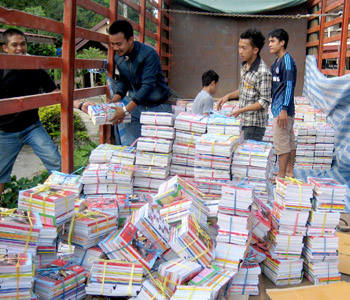 Six tons of books! We're making our first trip to the far south of Laos. It's a three-day drive to Xekong and Attapeu, two of the country's poorest provinces. Our teams will be away for 3 weeks going to some hard-to-reach schools, which are thrilled that somebody remembers them. In this picture, each bundle of books is enough for one classroom; a typical school will get 5 bundles, and we had to rent a bigger truck to transport them all. Six tons of books! We're making our first trip to the far south of Laos. It's a three-day drive to Xekong and Attapeu, two of the country's poorest provinces. Our teams will be away for 3 weeks going to some hard-to-reach schools, which are thrilled that somebody remembers them. In this picture, each bundle of books is enough for one classroom; a typical school will get 5 bundles, and we had to rent a bigger truck to transport them all.
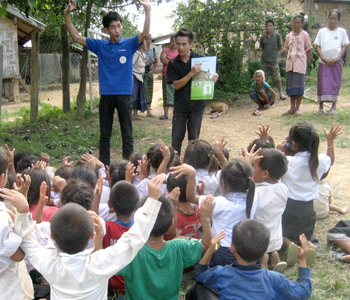 October 2014 October 2014
Souliphone joined our staff earlier this year as an artist. He's deaf, so we've all been learning some sign language. He came along with our book party team to a nearby school recently and offered a new activity: sign language lessons. This was a new concept and it took children a few minutes to understand what it was about but soon they were enthusiastically signing the words for buffalo, horns, and wide.
By chance, this village had a 4-year-old boy who is nearly deaf, and socially isolated. We're exploring ways we might teach sign language to him and his age-mates.
August 2014
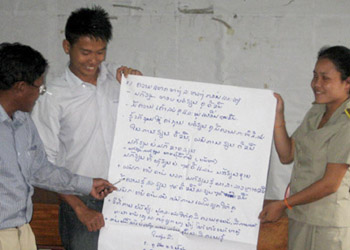 Our evaluations showed that a daily reading program does improve reading skills. We learned much more, too. One observation: Reading skills improved far more in some classrooms than in others. We invited teachers whose classes had improved the most to come to a one-day workshop, where we could ask if they had used any special techniques, that might benefit others. Our evaluations showed that a daily reading program does improve reading skills. We learned much more, too. One observation: Reading skills improved far more in some classrooms than in others. We invited teachers whose classes had improved the most to come to a one-day workshop, where we could ask if they had used any special techniques, that might benefit others.
As it turns out, they had not. Then we split them into three groups, and asked each group to discuss what were the elements of good teaching.
Nearly all the teachers we meet seem to believe that education consists of a teacher and a blackboard. That's how they grew up, and that's what they use. We had a problem during the trial of our reading progam, because after agreeing to do it, some teachers got nervous that "just" letting kids read was a failure to do their job, and reverted to teacher-and-blackboard mode.
So we were heartened when each of the three groups, in giving a report, said that other activities, including games and reading, were important too. Everyone reading this probably already thought so, but those are new ideas in Laos. Now we know that the teachers with this approach also have the classrooms that show the greatest improvement. That's one more bit of information we can use, as we encourage teachers to occasionally step away from the blackboard, and try other techniques.
July 2014
 Does our daily reading program ("Sustained Silent Reading") make any difference? The short answer is: Yes, but...
Does our daily reading program ("Sustained Silent Reading") make any difference? The short answer is: Yes, but...
We evaluated the impact of our program in 27 schools, and compared them with 13 schools that didn't get the program. The program did improve reading; given the low cost, it was a dramatic improvement. But we also found that many teachers, although they had agreed to do it, didn't actually do so. They were convinced that their job was to be at the blackboard teaching, and they would be shirking their duty if they simply let students read. We also found that reading levels were lower than had been reported. Few students in grades 1 and 2 could read even a simple word, and books didn't make a difference at those levels. Details of this evaluation are available as a PDF, please click for Evaluation Report: Sustained Silent Reading in Laos
Based on those (and other) findings, we've made changes in the program, found ways to improve implementation, and we're making a new series of books called I Can Read! which helps children learn to read. We'll continue with the improved program in September, and once again, will monitor and measure results.
April 2014
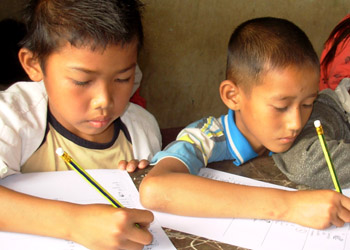 A reading test in a rural Lao school. Yes, pictures of children reading are more satisfying to look at. But these tests are a vital part of what we do. We measure the reading levels in each grade. We measure improvement within each grade at each school over the course of a year, and also compare the improvement in schools that got our reading program, to schools that didn't yet get it.
A reading test in a rural Lao school. Yes, pictures of children reading are more satisfying to look at. But these tests are a vital part of what we do. We measure the reading levels in each grade. We measure improvement within each grade at each school over the course of a year, and also compare the improvement in schools that got our reading program, to schools that didn't yet get it.
Next month we'll get back results from the first comparative evaluation, but even without that, the process has helped us to greatly improve our reading program. ("Cooperation" is a wonderful thing in daily village life, but it reduces the value of the testing. So students next to each other get similar tests but with different pictures and words.)
April 2014
 "Children are coming to school early, so they can read." Our daily reading program got off to a slow start at many schools. Teachers agreed to do it, then got cold feet. "A teacher and a blackboard" was the only education system they grew up with, and they were reluctant to take time away from that, "just" to let children read.
"Children are coming to school early, so they can read." Our daily reading program got off to a slow start at many schools. Teachers agreed to do it, then got cold feet. "A teacher and a blackboard" was the only education system they grew up with, and they were reluctant to take time away from that, "just" to let children read.
But we've worked through that in many schools. Once they see results, teachers become reading enthusiasts. "School opens at 8:00, but children come at 7:30 so they can read," reported one. Another told us: "Before, I wrote on the board, then I read it, then children repeated what I said. Now they read it while I write."
March 2014
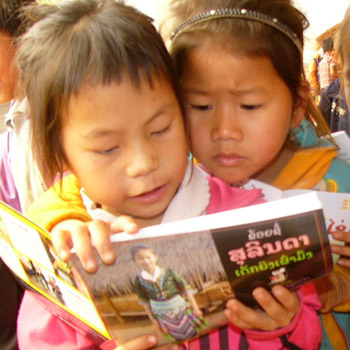 The first picture books in our "I AM" series, featuring boys and girls from the Khmu and Hmong ethnic groups, have been big hits. For the very first time, young readers see pictures of people "just like me!" in a book. These girls are immersed in I am Soulinda, about a Hmong girl.
The first picture books in our "I AM" series, featuring boys and girls from the Khmu and Hmong ethnic groups, have been big hits. For the very first time, young readers see pictures of people "just like me!" in a book. These girls are immersed in I am Soulinda, about a Hmong girl.
We've taken slightly different approaches with each book. A book about the Katang features three children instead of just one. The cover shows them getting water; picking edible leaves; and digging crickets which are a popular food;, and the sample page here shows an older brother casting a fishnet. These kids do play, too! But they help with household work often, and cheerfully.
March 2014
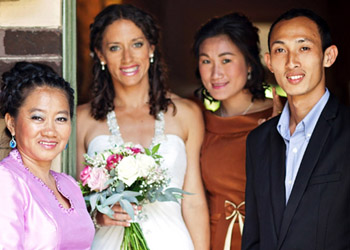 "Wow!" says Big Brother Mouse, using a word that has also become part of the Lao vocabulary.
"Wow!" says Big Brother Mouse, using a word that has also become part of the Lao vocabulary.
Emma Zalcman and Alex Van Der Meer Simo and their wedding guests generously donated enough to sponsor 2 books, as well as reading programs at 3 schools. One of the books is part of our new "I Can Read" series, which makes it fun for children to learn all the letters, one by one, by providing interesting things to read even when they know only a quarter of the letters. (Yes, that was a challenge to write!) Here's a photo from the wedding, showing Emma and friends, and one of the books.
January 2014
 We've posted many photos of children absorbed in their first book. Those are more exciting. But events like this workshop are part of that.
We've posted many photos of children absorbed in their first book. Those are more exciting. But events like this workshop are part of that.
On the 5th and 6th of January we held workshops for teachers from schools where we've started daily reading programs. We got their feedback about the program was going, and how we could help. Traditionally in Laos, "education" means a teacher and a blackboard; the idea that reading is a good way for students to learn is still new. Officials from the district education office joined us, and helped us stress the importance of reading.
At the end, we give a set of new books to every teacher, to take back to their school.
Archived News from 2006-2007.
From 2008.
From 2009.
From 2010.
From 2011.
From 2012.
From 2013.
|

